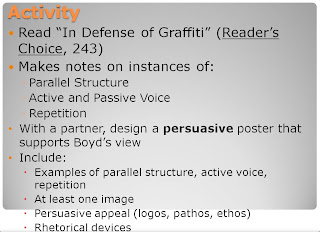Topic: Public Discussion Topic or Own Choice (but please discuss with me)
Particulars: Choose 4-6 “academic” resources that are highly relevant to your topic. Give full reference information for each source and thoroughly explain why each resource is appropriate and relevant to your topic. Additionally, include how each resource was found (include keywords used in any Google searching). Each annotated entry should contain three critical writing tasks: summary (an overview of the main points), analysis (logic and effectiveness of the argument) and evaluation (ethos, reliability of the author and argument).
Purpose: Learn basic methodologies of research, learn how to locate and evaluate information, learn how to find appropriate resources
Length: Each annotation should consist of at least one fully-formed paragraph with complete reference information in MLA style. Total length should be 2.5-4.5 pages.
DUE: 1st December 2009
EXAMPLE ANNOTATION
Lamott, Anne. Bird by Bird: Some Instructions on Writing and Life. New York:
Anchor Books, 1995.
Lamott's book offers honest advice on the nature of a writing life, complete with its insecurities and failures. Taking a humorous approach to the realities of being a writer, the chapters in Lamott's book are wry and anecdotal and offer advice on everything from plot development to jealousy, from perfectionism to struggling with one's own internal critic. In the process, Lamott includes writing exercises designed to be both productive and fun.
Lamott offers sane advice for those struggling with the anxieties of writing, but her main project seems to be offering the reader a reality check regarding writing, publishing, and struggling with one's own imperfect humanity in the process. Rather than a practical handbook to producing and/or publishing, this text is indispensable because of its honest perspective, its down-to-earth humor, and its encouraging approach.
Chapters in this text could easily be included in the curriculum for a writing class. Several of the chapters in Part 1 address the writing process and would serve to generate discussion on students' own drafting and revising processes. Some of the writing exercises would also be appropriate for generating classroom writing exercises. Students should find Lamott's style both engaging and enjoyable.
Notice the indentation of all the text except for the first line of the reference?
For more information and style guidelines, visit the Online Writing Centre: http://owl.english.purdue.edu/owl/resource/614/01/




























